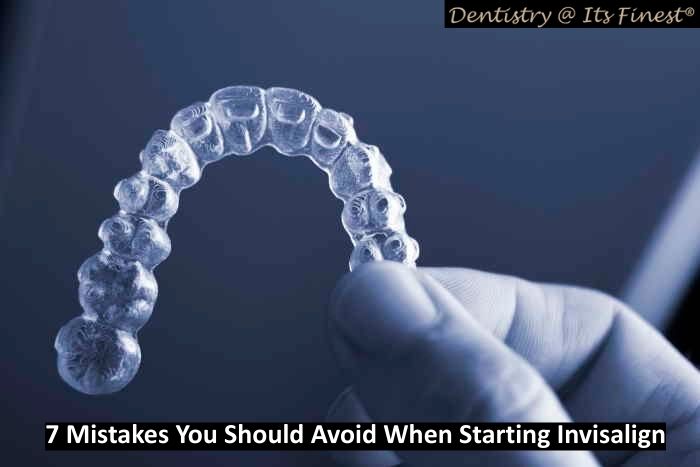What mistakes do new Invisalign users must avoid?
The mistakes new Invisalign users must avoid are choosing the wrong provider, skipping research, misunderstanding wear schedules, and neglecting hygiene. These missteps can delay progress, compromise results, or lead to unnecessary frustration. Below are the mistakes new Invisalign users must avoid.
1. You Are Not Seeing the Right Orthodontist
New Invisalign users often choose general dentists without confirming orthodontic credentials. Orthodontists specialize in tooth movement and complete additional training beyond dental school. Their clinics focus exclusively on alignment, offering better diagnostic tools, more predictable outcomes, and tailored treatment plans. General dentists may delegate cases to part-time orthodontists, but this split focus can reduce care quality. Always verify that your provider is a full-time orthodontic specialist.
2. You Don’t Research Your Invisalign Provider’s Scope
Patients frequently skip vetting the provider’s clinical scope. During your initial consultation, ask whether the office performs non-orthodontic procedures such as crowns or dentures. If the clinic operates as a general dental practice, consider continuing your search. Providers who focus solely on orthodontics are more likely to deliver consistent and high-quality Invisalign outcomes.
3. You Ignore the Invisalign Tier System
Invisalign ranks providers based on case volume and treatment proficiency. This tiered system reflects real-world experience rather than marketing. Bronze (0 to 4 cases per 6 months) signals minimal engagement, while Diamond Plus (200 or more cases) indicates deep expertise. Prioritize providers in higher tiers to ensure your treatment benefits from refined technique and proven success rates.
4. You Don’t Meet Daily Wear Requirements
Many users remove trays to relieve discomfort, unaware that inconsistent wear disrupts progress. Invisalign requires 20 to 22 hours of daily use to maintain tooth movement momentum. Short breaks for meals, sports, or hygiene are acceptable, but extended gaps reduce efficacy. Follow your orthodontist’s wear schedule precisely to avoid regression and prolongation.
5. You Expect Instant Results
Invisalign is engineered for gradual correction, not overnight transformation. Some users expect visible changes within days, overlooking the biological pace of tooth movement. Treatment timelines vary based on bite complexity, arch width, and compliance. Early-stage patients may need palate expanders or bite adjustments before aligners can take full effect. Set realistic expectations and monitor progress over weeks rather than hours.
6. You Neglect Daily Aligner Cleaning
Failing to clean aligners allows bacteria to accumulate, especially overnight. Morning breath and tray odor often stem from skipped hygiene routines. Brush your teeth and rinse trays immediately after waking. Use clear, unscented soap instead of toothpaste to avoid surface abrasion. Soak trays in denture cleanser weekly to dissolve plaque and maintain transparency.
7. You Use Toothpaste on Your Aligners
Toothpaste contains abrasives that scratch and cloud Invisalign trays. These micro-scratches trap bacteria and accelerate discoloration. Instead, clean trays with mild antibacterial soap or a baking soda and water mix. This preserves clarity, eliminates odor, and prevents microbial buildup. Always rinse thoroughly before reinsertion to avoid transferring residue into your mouth.
What should you not do with Invisalign?
When using Invisalign, avoid choosing a provider without orthodontic specialization, skipping research into their treatment scope, or ignoring their experience tier. Do not remove aligners for extended periods, expect rapid results, or neglect daily cleaning routines. Using toothpaste on trays can cause damage and discoloration. Each of these missteps can compromise treatment effectiveness, delay progress, or lead to hygiene issues.
What should you know before starting Invisalign?
The things you should know before starting Invisalign are the importance of wearing trays 20 to 22 hours daily, choosing a provider with orthodontic specialization, and setting realistic expectations for gradual progress. The treatment relies heavily on your consistency and your provider’s expertise. The hygiene routine is also non-negotiable because daily cleaning is essential.
What foods are off limits with Invisalign?
The foods that are off limits with Invisalign are anything consumed while wearing trays, including gum, sticky candy, and hard snacks that can damage or stain aligners. The foods that are risky also include sugary items between meals unless you brush immediately after. The key is not the food itself but removing trays before eating and maintaining oral hygiene.
How often should you clean your Invisalign aligners?
The times you should clean your Invisalign aligners are at least twice daily, once in the morning and once before bed. The aligners should also be rinsed every time they are removed and soaked weekly in a non-abrasive cleanser. The use of toothpaste is discouraged because it can scratch and cloud the trays.

